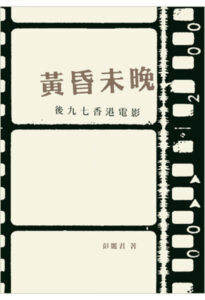
Pang Laikwan 彭麗君
The Chinese University of Hong Kong Press, 2010
Reviewed by Siyi Li (PhD Candidate in Cultural Studies, The Chinese University of Hong Kong)
The fall of Hong Kong cinema may be one of the most typical exemplifications of the decline of post-1997 Hong Kong; characterized by slow economic development as well as political frustrations. Yet, as the title of Pang Laikwan’s book “Sunset Not Yet” implies, Hong Kong exists in a delicate state of limbo, between optimism and pessimism. It seems that the author believes the aesthetics of failure and decline can provide us with important clues for reflection and new possibilities.
This book is a cultural study of Hong Kong cinema, especially its development and predicament since the return of Hong Kong to China in 1997. It includes textual analysis of specific films, case studies of quintessential directors and producers, close observation on industrial production and circulation, and theoretical reflections on the related meanings of social politics in reality. Since Pang places her research in a more complicated historical context of globalization, China’s rise, and the awareness of localism in Hong Kong, this study of Hong Kong cinema has turned into a key for rethinking the issues of Hong Kong itself: the fluctuation of its imagined local identity and collective anxiety of interacting with global capitalism and essential nationalism in the means of competition but also collusion.
Pang’s first few chapters focus on four specific Hong Kong filmmakers and their works, in order to discuss the relations between Hong Kong cinema and the issue of Hong Kong—Fruit Chan, Jackie Chan, Johnnie To and his Milkyway Image, and Wang Ching-po. Fruit Chan’s films are commonly interpreted as various allegorical versions of Hong Kong, implying a seemingly strong local subjectivity. But this kind of subjectivity depends on the ideology and paradigm of foreign film festivals. That’s to say, Fruit Chan’s films are made for foreign audiences rather than local ones. Jackie Chan is said to be one of the most successful Hong Kong actors in the world. Such success can be traced back to his use of tailoring performances to specific audiences in Hong Kong, Mainland China, and foreign countries. This is a kind of self-objectification, which is also adopted by the mainstream discourse of Hong Kong tourism.
Johnnie To and Wang Ching-po are two sides of the same coin. Although both inherit the most notable genre film in Hong Kong—the gangster film—they perceive the logic of commercial films in opposite ways. Johnnie To’s works represent the last peak of the gangster film in Hong Kong and its limitations; his emphasis on masculinity and brotherhood is identical with the nostalgia of the once familiar urban space of Hong Kong. On the other hand, Wang Ching-po lives on the gangster film’s margins; his failure resulted from the immaturity of his artistic method that still reflects some resistance to the same urban space as well as the same commercial logic. According to Pang, the above four cases share some ambiguities in common, reminding us that there is neither a pure local identity or image of Hong Kong nor a self-evident subjectivity that can be taken for granted.
Turning from texts and theories to the film industry, the next three chapters investigate filmmaking in Hong Kong under the influence of China’s rise and global capitalism, the battle of copyright and the hegemony of Hollywood, and the circulation of violence on the screen. Pang argues that the local identity of Hong Kong not only originates from native feelings but also a product of globalization; presented as a trans-local phenomena in the production and consumption of Hong Kong cinema. Here, Pang points out that the unique style of Hong Kong cinema rests on both its imitations of others and its imitators through a detailed examination of both copyright and circulation. At last, Pang reminds us that we should understand Hong Kong cinema in the context of the place-making of Hong Kong in recent years, with its struggle between the global market and the narrative of China’s nationalism, other than taking films as a simple reflection of social reality.
Finally, the deconstruction of local identity of Hong Kong does not conclude the acceptance of any other essentialist grand narratives. The myth of the local and the myth of nation state are equivalent in the dimension of ideological function in this book. Hong Kong, a unique place with its own history and culture, is what we can appreciate, interpret, criticize and finally understand as this book does. After all, it’s just one of many unique places throughout the world.
